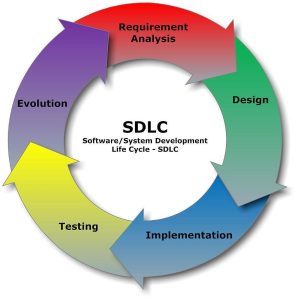In the ever-evolving landscape of technology, software development is at the forefront of innovation. Whether it’s creating applications for mobile devices, building enterprise-level software solutions, or developing complex algorithms for artificial intelligence, the process of software development follows a structured approach known as the Software Development Lifecycle (SDLC). This framework encompasses a series of phases that guide developers from initial concept to final product, ensuring efficiency, quality, and successful project delivery.
The Phases Of SDLC
Planning: The journey of software development begins with planning. During this phase, stakeholders define the project scope, objectives, requirements, and constraints. Key considerations include budget, timeline, resource allocation, and risk assessment. Establishing clear goals and expectations lays the foundation for the entire development process.
Analysis: In the analysis phase, developers delve deeper into understanding the project requirements. This involves gathering and analyzing user needs, conducting feasibility studies, and defining system functionalities. By identifying potential challenges and opportunities, developers can devise effective strategies to address them.
Design: With requirements in hand, the design phase focuses on creating a blueprint for the software solution. This includes architectural design, database design, user interface design, and system specifications. Design decisions are crucial as they shape the structure, functionality, and user experience of the final product.
Implementation: The implementation phase marks the actual development of the software. Developers write code, integrate components, and build features based on the design specifications. Collaboration and communication among team members are essential to ensure consistency, code quality, and adherence to coding standards.
Testing: Quality assurance is paramount in software development. During the testing phase, developers rigorously test the software to identify and fix defects, errors, and vulnerabilities. Testing methodologies may include unit testing, integration testing, system testing, and user acceptance testing. The goal is to ensure that the software meets functional, performance, and security requirements.
Deployment: Once the software passes testing and receives approval from stakeholders, it is ready for deployment. This involves installing the software in the production environment, configuring settings, and preparing for launch. Effective deployment strategies minimize downtime, streamline the transition, and maximize user adoption.
Maintenance: The final phase of SDLC is maintenance, where the software is continuously monitored, updated, and supported throughout its lifecycle. This includes bug fixes, feature enhancements, performance optimizations, and addressing user feedback. By maintaining the software’s relevance and reliability, organizations can maximize its value and longevity.
Popular Software Development Models
Software development firms often adopt various models to manage their projects efficiently. These models provide structured frameworks for organizing tasks, managing resources, and delivering quality software products. Here’s a detailed look at some of the basic and popular models widely adopted in the industry:
A. System Development Life Cycle (SDLC) Model
Also known as the Classic Life Cycle Model or Waterfall Method, SDLC follows a linear and sequential approach to software development. It consists of several key activities:
1. System/Information Engineering and Modeling
Before software development begins, the system requirements are established, and the necessary elements are defined. This includes understanding the system’s interaction with hardware, people, and other resources.
2. Software Requirement Analysis
The development team conducts a feasibility study to understand the customer’s system and identify potential areas for software automation. This phase culminates in a detailed document outlining specific recommendations for the system.
3. System Analysis and Design
During this phase, the software’s overall structure and architecture are defined. Design decisions encompass factors such as client/server technology, database design, and data structure design.
4. Code Generation
The design is translated into machine-readable code using programming languages like C, C++, or Java. Programming tools such as compilers and debuggers aid in the generation of code.
5. Testing
Once the code is generated, rigorous testing begins to uncover and rectify any defects or bugs. Various testing methodologies and tools are employed to ensure the software meets functional and performance requirements.
6. Maintenance
After deployment, the software undergoes maintenance to accommodate changes or updates that may arise during its lifecycle. This phase ensures the software remains relevant and functional.
B. Prototyping Model
The Prototyping Model is an iterative approach where a simplified version of the software, called a prototype, is developed and presented to the customer for feedback. The cycle of prototyping, evaluation, and refinement continues until the final product meets the customer’s expectations.
C. Rapid Application Development (RAD) Model
The RAD model emphasizes rapid prototyping and iterative development to accelerate project delivery. It involves:
1. Business Modeling: Analyzing information flow among business functions.
2. Data Modeling: Defining data objects and their attributes.
3. Process Modeling: Describing processing steps for data objects. 4. Application Generation: Utilizing RAD tools for software construction.
5. Testing and Turnover: Minimizing testing time by reusing tested components.
D. Component Assembly Model
Object-oriented technologies form the basis of the Component Assembly Model, which focuses on software reusability and integration. Key aspects include:
1. Object-Oriented Paradigm: Creating reusable classes encapsulating data and algorithms.
2. Component Integration: Assembling existing software components to accelerate development.
3. Software Reusability: Leveraging component libraries and pre-built solutions for efficiency.
These popular software development models offer diverse approaches to managing projects, catering to varying requirements, timelines, and project scopes within the software development lifecycle.
Conclusion
In today’s commercial software development landscape, integrating various methodologies is common practice. Time is of the essence in software development, as delays can result in losing market share to competitors. Conversely, rushing a product to market with numerous bugs can tarnish a company’s reputation. Therefore, striking a balance between development speed and product quality is essential. While customers understand that perfection is unattainable, they do expect user-friendly solutions that meet their needs.
At Insight Consultants, we specialize in leveraging diverse software development methods to craft solutions that empower enterprises and enhance lives. With our technological expertise, we embed applications with the necessary business intelligence and carefully assess the most suitable framework and methodology for each unique project. Our approach ensures ethical delivery of services and impactful outcomes for our clients.





